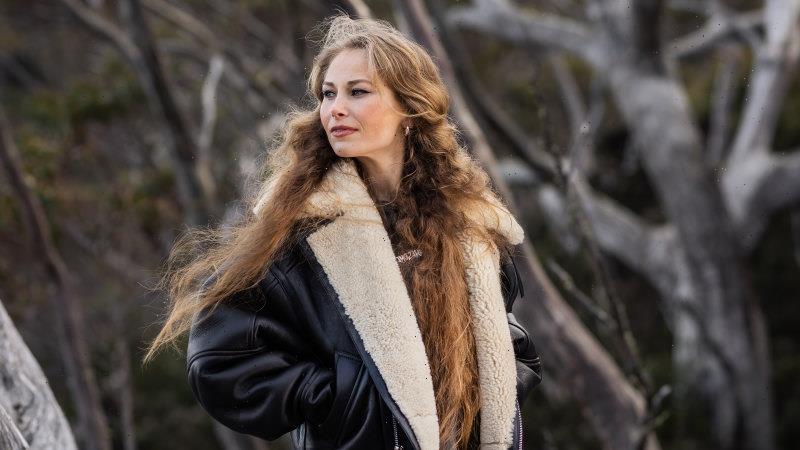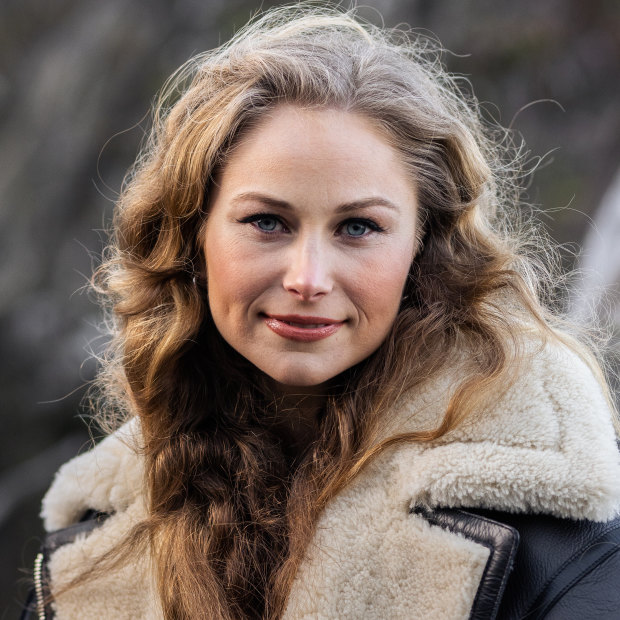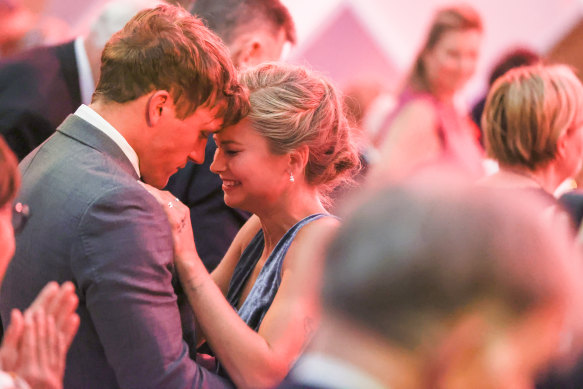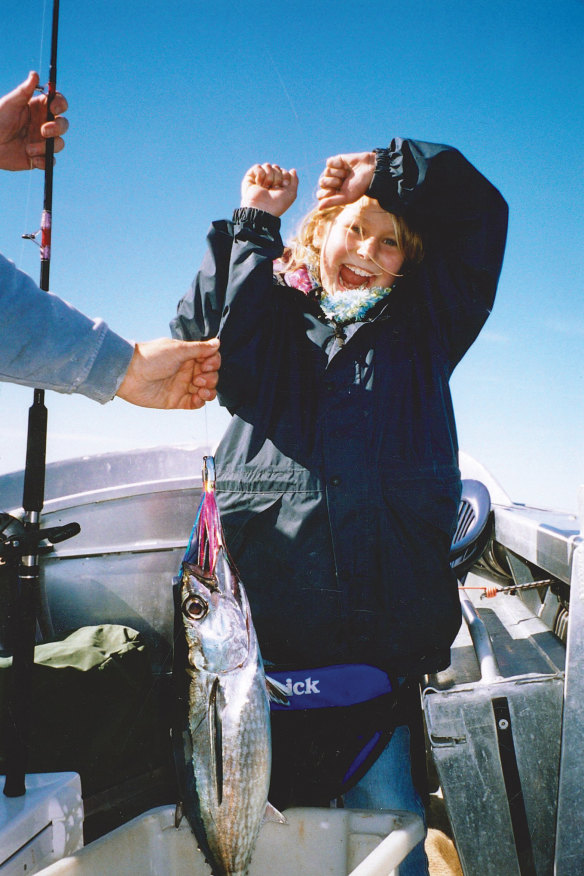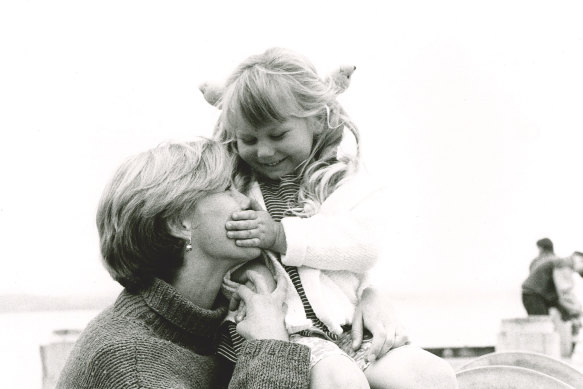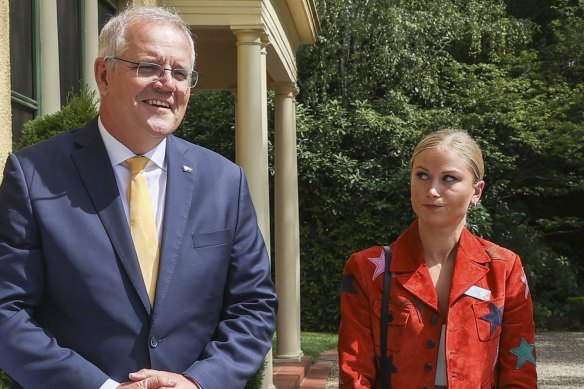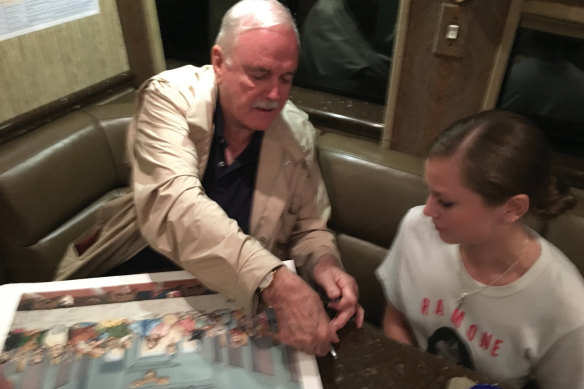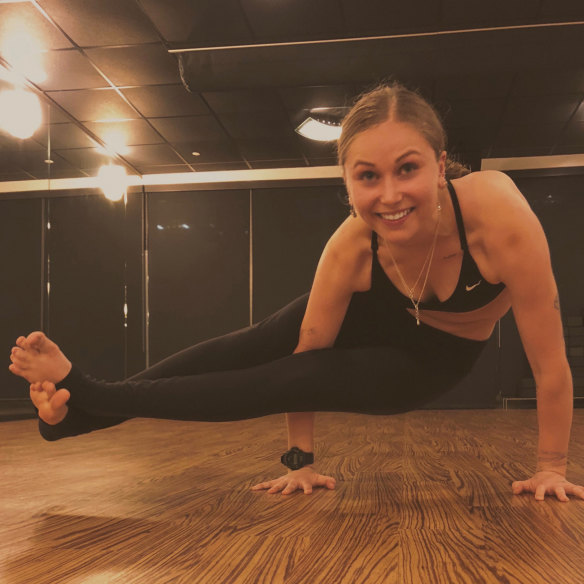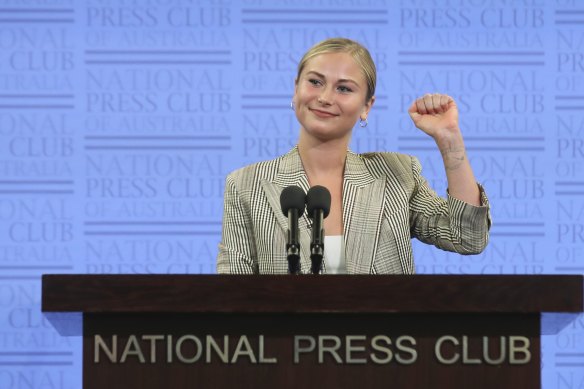By Jacqueline Maley
“With every new story that’s written about me by a different person, there’s a shift of the kaleidoscope,” Tame says. “And things get further and further away from the truth.”Credit:Adam Gibson
Grace Tame is tiny, as though her physical self is in inverse proportion to her mighty character. When she walks through the door of Abundance on the Quay, a cafe in Hobart’s harbourside suburb of Bellerive, on a grey and icy Monday morning, I miss her at first. It’s only when she’s closer that I see how distinctive the 27-year-old is – she is gamine and girlish, decked out in a vintage Black Sabbath T-shirt, black leather jacket, wide-legged jeans and Doc Martens platform boots with yellow stitching. The aesthetic is ’90s grunge girl meets punk, and it is completely sui generis, just like Tame.
“I’m a hugger,” she tells me, and we vacillate over how to greet each other before settling on a handshake. Tame seems nervous, which confounds expectations – this is a woman whose catchcry is “Let’s make some noise”, who has the words “Eat my fear” tattooed on her right hand. The reason, perhaps, is that she’s in new territory – here not as an activist, or child sex-abuse survivor, or Australian of the Year, or prime minister-botherer, or Twitter provocateur, but as a writer.
We’re meeting to discuss her forthcoming memoir, The Ninth Life of a Diamond Miner. The book was the subject of a fierce bidding war among publishers before Tame had even written a word, with first offers rumoured to have started at $200,000. Pan Macmillan eventually secured the book for an undisclosed sum.
Writers often talk about their “process” – the different ways in which they overcome the torture of producing a book. Grace Tame’s process was about as Grace Tame as it gets – after scrapping a first draft, she wrote all 330 pages of a second draft in three months, sometimes working late into the night. She was writing right up until the book was scheduled to go to print, turning out the last pages even as I was reading the near-to-final draft in preparation for our interview.
“I am a hyper-focused type of person,” she says by way of explanation. “I do everything in one go. I’m not about spreading things out over a long period of time. I sort of become the thing I’m doing.”
The book is a wild ride. We learn about Tame’s sprawling but close family, the effect of her parents’ divorce when she was a toddler, her sexual abuse by an older child when she was six, her teenage struggles with anorexia (for which she’s been hospitalised twice), her youthful, short-lived marriage to Hollywood child star Spencer Breslin (his biggest role was in the 2003 film version of The Cat in the Hat), her stint studying art and discovering herself in the Californian coastal city of Santa Barbara, her unlikely friendship with John Cleese and his daughter Camilla, and her views on everything from the late Robin Williams to structural inequality in the United States.
Tame with now-fiancé Max Heerey at the 2021 Australian of the Year Awards ceremony. Credit:Alex Ellinghausen
Even obscure subjects such as Diego Rivera, the artist husband of Frida Kahlo, are fixed in the author’s sights. Describing her travels in America, Tame tells us she enjoyed a visit to Rivera’s home turned museum in Guanajuato, Mexico. “Not that I’m fond of that adulterous prick,” she concludes, with Tamesian flourish.
But there’s a sinister suspense which hangs over the first half of the memoir, as you wait for the author to be violated in the way you know she will be. Was it difficult to revisit the abuse, and the grooming that led up to it?
“I mean, yes and no,” she says. We have ordered tea and Tame is looking at me intently, her eye contact direct. “It is a wholly regenerative process. It doesn’t seem to matter how depleted I become, when I find myself in front of a receptive audience who are there to hear the message, who are open to receiving and connecting, their energy recharges you.”
The schoolteacher who abused 15-year-old Tame, Nicolaas Bester, still lives in Hobart, not so far from the cafe in which we sit. He’s a constant presence in her book, even when she’s not explicitly writing about him. He’s still present in her consciousness; our conversation loops back to him often.
He hovers online and, a week after we meet, Tame is in the news again after she reported threatening tweets he made about her. The tweets refer to a “comeuppance” in four weeks’ time – an apparent reference to the timing of her memoir’s publication. Tasmania Police says it is “assessing” the complaint.
“I did wonder if this memoir would have been more powerful if I wrote less about the abuse and the man who perpetrated it.”
“I did wonder if this memoir would have been more powerful if I wrote less about the abuse and the man who perpetrated it,” Tame writes before she begins the section on the abuse. “But then I realised that … my self-esteem has rebuilt such that I believe I will write more books.”
Tame had creative control over the vision and execution of the book, with publisher Cate Blake physically sitting with her through many hours of writing sessions, acting as a sounding board. “Having that solidarity or companionship was crucial to keeping her on track,” says Blake. “Once I realised how strong Grace’s creative instincts were, I had faith this was a book readers will follow her on.” The result is wordy and wild, long and discursive, with a squirrelly structure (Blake calls it “idiosyncratic”) that defies the conventions of memoir. But it has the one thing, maybe even the only thing, that a book really needs – a strong voice.
You can say a lot about Grace Tame and, from columnists Andrew Bolt and Peter van Onselen to the army of trolls she confronts on Twitter, many people have. But she will never back down from a fight, and she will never allow her critics the last word.
Her voice is Hulk-like, irrepressible. The pages of her book thrum with it.
“I’ve always loved the outdoors,” says Tame, pictured here as a child.
We’re sitting on pots of lemongrass tea. Tame seems more relaxed, although “relaxed” is not an adjective that fits her well. Her conversation is animated and constant, and she’s a big gesticulator.
“It was an opportunity to part ways with a part of myself,” Tame says of the book, “and to honour important people in my life. My editor was really drumming it into me when I was writing: ‘Don’t write for the critics, don’t write for the critics.’ ”
Her critics are legion, and they multiplied last year as Tame picked up a head of steam with her censure of Scott Morrison’s government or, as she calls it, the “Scott government”, her clap-back at the former PM’s habit of using women’s first names in his speech.
The book has been incredibly tightly guarded, even within the publishing house, where only a select few have seen the proofs. It will be published in hardback, and the cover is an allegorical artwork drawn by Tame herself. I had to sign a non-disclosure agreement before reading it, and the timing of its publication, September 27, means it’s positioned squarely at the big-bucks Christmas market, a slot usually reserved for bestselling novelists and big-time celebrity memoirs.
Her publisher will be hoping her army of fans – she had about 220,000 Twitter followers before deactivating her account earlier this month, and has nearly 240,000 on Instagram – will shell out the $49.99 cover price, wanting to read more about the woman who captured so much press attention in 2021.
Since shooting to fame as Australian of the Year in January last year, Tame has been offered gigs with L’Oréal Paris, Nike and the Young Global Leaders program, all of which she turned down. For a woman whose message is her voice, writing a book was the natural next step. She likes to tell her own stories. “With every new story that’s written about me by a different person, there’s a shift of the kaleidoscope each time,” she says. “And things get further and further away from the truth.”
Tame with her mother, Penny.
Tame’s take-no-prisoners attitude is a straight-up survival mechanism, part of the armour she needs to protect herself from the ongoing effects of her sexual abuse by Bester, who was jailed twice – once for his physical abuse of her, and again when he boasted about his child sexual abuse on Facebook. He served less than two years behind bars for both crimes.
“Play with fire with me? I’m holding a jerrycan, so good luck,” Tame says in reference to both Bester and her critics. “I haven’t always had that jerrycan. I’ve had to pick it up because I am five foot three [160 centimetres], and I was no match … there’s no match for that man.”
This mindset, combined with rapid-onset fame, was a tricky combination to navigate. It was also a tricky combination for many to accept. For anyone wanting to project unvarnished goodness onto their victim-heroes, Tame was an outrageous disappointment.
Businesswoman and feminist stalwart Wendy McCarthy, 81, has huge admiration for the way Tame combines the personal with the political. “She can roar from the rooftops for the rest of her life as far as I am concerned,” McCarthy says. “But I found it really confronting that a lot of women my age and 10 years younger were very disapproving of her.”
“My instinct is always to defend myself. I have to do better at times, I am still learning.”
Tame admits she’s made mistakes, but does not specify what they were. “It was like getting drop-kicked by Buddy Franklin past the 50-metre line,” she says of her rapid introduction to the public spotlight. “My instinct is always to defend myself. I have to do better at times, I am still learning.”
The criticism of Tame culminated when she was photographed scowling at the then-prime minister at an Australian of the Year reception on January 25. Tame was about to hand over the baton after her time in the role, but she didn’t go without a final, visually brutal message about what she thought of Scott Morrison, particularly his handling of issues of sexual assault and respect for women. This is not something she counts as a mistake.
Tame with then-prime minister Scott Morrison at an Australian of The Year function earlier this year.Credit:Alex Ellinghausen
“Like many people, I wasn’t a big fan,” she says of Morrison. “Max [Heerey, her fiancé] and I were standing there. I said, ‘I can’t smile at him, I can’t. I’m not smiling at him.’ ”
The frown divided public opinion, between those who thought it was ill-mannered and disrespectful of the office of the prime minister (Jenny Morrison herself said it was “disappointing”) and those who admired the gumption of a young woman, for once, not smiling and pretending everything was just fine when she didn’t think it was. As Tame writes in her memoir: “Anyone who’s seen pictures of my face knows I can’t hide my feelings for very long.”
After spending three hours in her company, I concur. It’s as though Tame is barely conscious of her labile expressions, let alone able to master them. But her defiant attitude doesn’t mean she is impervious. “When you’ve grown up with instability … when you get criticism from all angles, it’s particularly damaging to your self-esteem,” she says.
“Because you feel like you don’t have an emotional base?” I ask.
“Yeah,” she says, quietly.
When Grace Tame finished high school, she left home for Santa Barbara, where she’d spent time as a teenager on a holiday with family friends, and which she loved. “I ran away,” she tells me bluntly. “I ran away when I was 18.”
Even though Tame hadn’t been publicly identified as Bester’s victim at that point (indeed, she was constrained by law from identifying herself or speaking about the abuse), the rumour mill had done the work for her. “Hobart is a very insular environment and I remember the gossip,” she says. “I remember being in a nightclub and young people under the influence of alcohol having that Dutch courage and coming up to me and saying things to me.”
What hurt more than being identified was the way in which some people seemed to frame the abuse – that she was the girl who’d “had an affair” with her teacher. “When you don’t have control over when that’s going to end, and you’re trying to build your self-esteem, and you just want anonymity, that’s very hard,” she says of the gossip. “I didn’t have control over the narrative.”
This has been a source of enduring frustration since – frustration and occasional rage. She often expresses this anger on social media – for example, tweeting her rewrites of media headlines which she feels let predators off the hook in their construction.
After fleeing Hobart for the warmth and anonymity of California, there followed six formative years in which Tame studied, partied, travelled, made friends and had relationships at a pace and with an abandon that is dizzying to read about.
I remark on how cool she seems in this period – forever listening to Lou Reed on New York balconies, getting tattoos and discovering the healing powers of beach yoga at dawn. Her wedding to Breslin was Elvis-themed, and took place on a ranch in the San Fernando Valley (they split in 2018). She makes a strangled groaning noise: “‘Cool’ covers all manner of sins, doesn’t it?”
Tame with John Cleese, for whom she worked as an illustrator.
Tame was experimenting with drugs, including pot and cocaine (she even worked on a marijuana farm for a while), something she discusses with frankness. “There have been times in my life where I have sincerely enjoyed myself while being high on drugs,” she writes. “As much as there is harm in glorifying [drugs] … I also know there is serious harm – immense harm – in looking down on people who are at difficult points in their life.”
She also writes poignantly about the experience of finding her sexuality after surviving child sexual abuse. For a long time, she was unable to lie on her back and look at the ceiling, she tells me, because it took her back to the abuse. At other times, she would freeze during sex with new people, and have intense flashbacks. “It is what it is, and you learn to ride it out. Ride the wave. That’s one of the lessons, I guess, of drug-taking and why I don’t do it any more … it doesn’t help you.”
Her trauma affected her relationships and led some suitors to reject her, further hardening her protective skin. As she writes of one guy: “Harrison was also one of the few men who at least had the decency to tell me directly when the weight of my trauma became too heavy for him to bear.”
It’s one of numerous parts of the memoir when your heart cracks for the young Grace Tame, who always seems to be working so frantically hard to play the cards she’s been dealt.
Grace Tame is beautiful: there is no denying it. Today, she wears red lipstick, blusher and immaculately drawn cat’s-eye eyeliner, with her hair pulled up into a high plait. She has lush eyelashes, exquisite cheekbones and a pixie nose with the ghost of a piercing in the right nostril.
In her memoir, Tame writes that “people assume many things about me based on the way I look … I’m not sure whether I was seen to be an easy target, a soft touch, a belt-notch, a good story or someone who would have sexual knowledge beyond their years.”
I ask Tame about the relationship she has with her looks now. Her body image “is always going to be a struggle”, she says. “I’m lucky that, after 10 years, I’ve met a man who is only six weeks older than me. He doesn’t ‘see’ my body, you know? It’s different. We have a relationship that transcends that.”
In June 2021, Max Heerey, a Hobart boy, quit his job in finance to support Tame’s speaking schedule and media appearances. He often handles media inquiries for her, and is a director of the Grace Tame Foundation. The couple met in 2020 on the social running app Strava. They began chatting via the app, before meeting for dinner at a south-east Asian restaurant in Hobart on AFL Grand Final day (this is how Tame knew Heerey must really like her).
“Once I got rid of my nerves, I was falling in love,” Heerey tells me. “I thought she was incredible straight away. We had so much in common. She is hilarious, she is beautiful. It was just one of those things that clicked.”
Heerey knew who Tame was before they met. He’d attended the Catholic “brother” school to Tame’s St Michael’s Collegiate. They were in the same year. I ask whether he was intimidated by Tame’s personal history. He says he’s never thought about it before; this is the first interview he’s given. He asks if he can send me his thoughts later, and does so the next day.
“I definitely wasn’t intimidated by Grace’s life experience. I was more concerned that I wasn’t good enough for Grace,” he emails. “Before meeting Grace, I was your stereotypical private school/public school boy with little to no trauma education … I am still learning.” Heerey tells me that when he and Tame were first dating, people made comments like “She is ‘damaged goods’ ” and “You won’t last long with her, she has too much baggage”.
“I’m not mentioning these comments to shame people,” he writes. “I am mentioning them to highlight society’s lack of understanding and education, myself included. Statistics say that the people who made those comments have family, friends or even partners who’ve been abused. Perhaps for young men, the impact of our own behaviour is hard to face.”
“What’s she like?” More than anyone else I’ve interviewed, friends and family were curious to know how Grace Tame was in person, such is the celebrity-esque fascination with her. Many who’ve never met her have decided they don’t like her. Others adore her for her adamantine defiance. Everyone seems compelled by her. It’s as if she sits right at the junction of contemporary conversations about misogyny, cancel culture and female rage. Writing about the prickly aspects of Tame, and the criticisms made of her, I find it hard to know what’s real and what’s internalised sexism: how far will I turn the kaleidoscope in writing about her?
Tame switched from using drugs as a soothing mechanism to practising yoga, which she also teaches.
Is she difficult or direct? Is she rude or just lacking pretence? Does her obduracy damage her cause or serve it? Where is the truth of someone so complex? The problem, if it is one, of Tame’s inflexibility makes sense to me after I read the section of her memoir in which she recounts her abuse by Bester.
It is a bell-clear account of grooming. Tame depicts lucidly how Bester manipulated the adults around him at the same time he was conditioning her. As she says, he was charismatic and intelligent and “he really didn’t bother hiding”.
Predators commonly desensitise their victims by gradually introducing sexual topics into conversation before beginning physical abuse. Bester was a master at this. He was known for his “irreverent” sense of humour, which meant that when he made sexualised jokes and innuendos with his young female students, no one pulled him up.
“Through innocent, permissive laughter, we became acquainted with a supposedly harmless man,” Tame writes. “He just pushed the boundaries, that was all. He meant well. He was a man of faith, after all.”
Most gallingly, the memoir lays out how Bester was already on the school’s radar for inappropriate conduct with the young girls of Collegiate. He was warned, for example – but allowed to stay in his role – for an incident in which he referred to a former student who’d fallen pregnant as “as easy as McDonald’s drive-through”.
He sought Tame out. She was struggling with her eating disorder and he began to offer her counsel and comfort. The comfort moved from words to hugs. He gave her a key to his office. He knew she was a budding artist, and he suggested she draw herself naked “to help with my body-image issues”. This sketch was later handed back to Tame by the police who’d collected it from Bester, along with an envelope of her hair, as part of their evidence against him.
He attempted to visit her when she was hospitalised for her anorexia. He showed up at her part-time job – a fellow teacher saw this and reported him, again, to the school. The principal rang a solicitor for advice, Tame writes, but again, no action was taken.
Suspicions roused, Tame’s parents had two meetings with the school to ask that he be kept away from their daughter. This made him angry with Tame. He punished her with the silent treatment, which made her desperate for his approval, further priming her for the physical abuse that was to come.
In a meeting with the principal, Bester portrayed Tame as an “unstable” kid who was seeking him out. It was an easy case to make. “He was very good at what he did,” she writes. “He coolly laid the groundwork for a narrative in which I was the supposed aggressor, and the mentally ill one that he felt ‘sorry for’. This would, in effect, be his line of defence in court.”
Following that meeting with the principal, Bester began his physical abuse of his 15-year-old anorexic student. He mostly had sex with her on school premises. Tame convinced herself she was in love with him – something she finds very painful to recall as an older person. She began cutting herself and drinking alcohol at school.
Reading Tame’s account of the grooming and abuse, you’re left in no doubt about the kind of person Bester is – a malignant predator. But sometimes, talking to Tame, it’s as if she’s still arguing the case to herself. “I have been to counselling,” she says. “I have wondered if, much like a passive smoker catches lung cancer, I have wondered, ‘Oh my god, am I a psychopath?’ That’s how effective these – excuse my English – these f—heads are, at making you feel like a bad person.”
She pauses. “I wish I never took his class,” she continues plaintively, and I feel as if I’m overhearing her internal monologue. “I wish I’d never met him. I know I was a weird kid … I always was.” I ask Tame what she’d tell her 15-year-old self if she could meet her now: “I would just say, ‘It’s not your fault.’ ”
“I have wondered, ‘Oh my god, am I a psychopath?’ That’s how effective these f—heads are, at making you feel like a bad person.”
I reflect on this comment later; perhaps this is why Tame doesn’t do compromise. When the demons in your head tell you the abuse is your fault, you need to hold the line against them. You cannot give any quarter at all. This is the way Tame sees it, too: if you loosen the boundaries of correctness just a little – shrug away an off-colour comment from a teacher, dismiss a piece of innuendo as just a joke, allow the teacher to take the 15-year-old girl to his office and shut the door – you invite evil in.
And unlike many of us, she knows what that looks like.
Tame is settled in Hobart now, after her years in California, and after the madness of 2021. “It was a lot of pressure,” she says of her stint as Australian of the Year. Since becoming a public figure, she’s had to ask herself big questions about what she wants in life. She’s been presented with “incredible opportunities”, including corporate partnerships and an invitation to join the Young Global Leaders program – New Zealand PM Jacinda Ardern is a member, alongside other entrepreneurs, innovators, activists, politicians and others.
Tame addressing the National Press Club after accepting Australian of the Year in 2021.Credit:Alex Ellinghausen
“But I turned all of them down,” she says. “I’m not interested in those things. Once you hand yourself over to somebody else, you inevitably compromise your values.”
I ask if she ever feels as if she’ll reach a point where she doesn’t think much about her abuser.
“Yeah, he’ll f—in’ die one day,” she says, het up.
“Is that what it will take?” I ask.
“I don’t know,” she says, quietly now. “I can’t say. I do weekly therapy and I am open and honest and I cannot take away what happened.”
We talk about anger for a while, its uses and its detriments, and about how to know when it’s time to drop it. “Anger can be very propulsive. Rage saved my life in the end as a 16-year-old,” she says, referring to her decision to report Bester to the school. “But rage has to be offset. Rage for rage’s sake is corrosive and it’s unproductive.”
“Anger can be very propulsive. Rage saved my life in the end as a 16-year-old.”
Here are the things that help: her 20-week-old puppy Zappa (named after musician Frank). The bushland, beaches and mountains of her patch of Hobart. Her wide network of friends and family. Max. Nowadays, in lieu of using drugs, Tame runs, cycles, walks and practises yoga to soothe herself.
Alongside her book publicity demands, her focus going forward will be on the Grace Tame Foundation, the charity she set up in 2021, and which was accorded deductible gift recipient-status on July 1 this year. The foundation, which Tame says has attracted “around half a million dollars” in donations, helps with the legal fees of survivors of sexual abuse, and is lobbying for consistent nationwide laws around sexual assault of minors.
“Currently we’ve got eight jurisdictions that govern the issue of sexual assault. The discrepancies give the appearance of an inconsistent approach that really benefits perpetrators,” she says.
The foundation’s three directors are Tame, Heerey and Tame’s stepfather, Ron Plaschke, a former CSIRO scientist and Australian Institute of Company Directors graduate. According to the foundation’s website, none draw a salary. Tame reiterates this to me, and says they initially created a tight board structure – which she expects to broaden – because “when you’re fighting against child sexual abuse, especially down here in Tasmania … you can’t trust many people … people have agendas. We are not a huge foundation and we don’t have dollar signs in our sights, and I don’t have dollar signs in my sights.”
She can see a time when she’ll step back from public view and advocate behind the scenes. “In writing my memoir, my story tells itself in a way,” she says. “By telling the stories, that shift towards prevention will naturally occur. That groundwork has been laid and I will always be proud of that. I can do some other things, and maybe write some other books.”
As we wind up our interview, I ask Tame to sign my manuscript. It’s the thing that really makes you feel like an author.
Support is available from the National Sexual Assault, Domestic Family Violence Counselling Service at 1800RESPECT (1800 737 732).
To read more from Good Weekend magazine, visit our page at The Sydney Morning Herald, The Age and Brisbane Times.
Most Viewed in National
Source: Read Full Article
